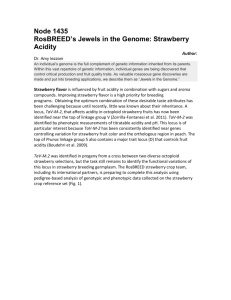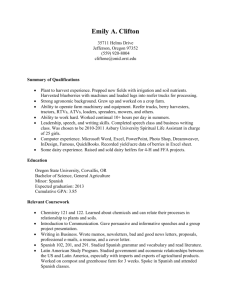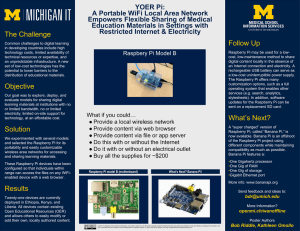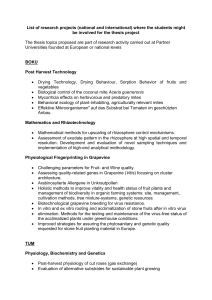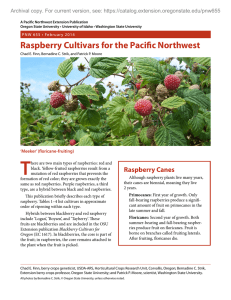USDA-ARS Small Fruit Breeding Program
advertisement
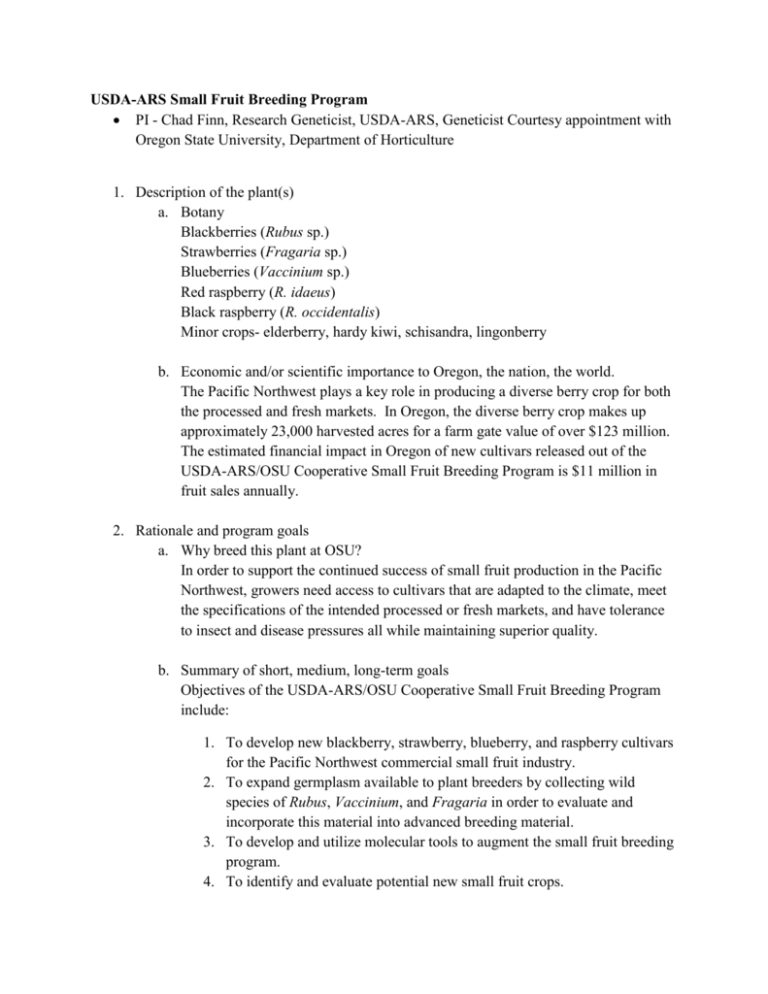
USDA-ARS Small Fruit Breeding Program PI - Chad Finn, Research Geneticist, USDA-ARS, Geneticist Courtesy appointment with Oregon State University, Department of Horticulture 1. Description of the plant(s) a. Botany Blackberries (Rubus sp.) Strawberries (Fragaria sp.) Blueberries (Vaccinium sp.) Red raspberry (R. idaeus) Black raspberry (R. occidentalis) Minor crops- elderberry, hardy kiwi, schisandra, lingonberry b. Economic and/or scientific importance to Oregon, the nation, the world. The Pacific Northwest plays a key role in producing a diverse berry crop for both the processed and fresh markets. In Oregon, the diverse berry crop makes up approximately 23,000 harvested acres for a farm gate value of over $123 million. The estimated financial impact in Oregon of new cultivars released out of the USDA-ARS/OSU Cooperative Small Fruit Breeding Program is $11 million in fruit sales annually. 2. Rationale and program goals a. Why breed this plant at OSU? In order to support the continued success of small fruit production in the Pacific Northwest, growers need access to cultivars that are adapted to the climate, meet the specifications of the intended processed or fresh markets, and have tolerance to insect and disease pressures all while maintaining superior quality. b. Summary of short, medium, long-term goals Objectives of the USDA-ARS/OSU Cooperative Small Fruit Breeding Program include: 1. To develop new blackberry, strawberry, blueberry, and raspberry cultivars for the Pacific Northwest commercial small fruit industry. 2. To expand germplasm available to plant breeders by collecting wild species of Rubus, Vaccinium, and Fragaria in order to evaluate and incorporate this material into advanced breeding material. 3. To develop and utilize molecular tools to augment the small fruit breeding program. 4. To identify and evaluate potential new small fruit crops. 3. Current Research Projects a. Focus Blackberry- To develop a thornless, cold-hardy, machine harvestable berry that is firmer than ‘Marion’ but has similar fruit quality characteristics. Strawberry- To develop high yielding, large fruited varieties for ease of picking, with excellent flavor and processing characteristics. Red Raspberry- To develop primocane fruiting cultivars that have better flavor, larger fruit, and higher yields or a different season than present cultivars. To develop floricane cultivars that have excellent processing or fresh characteristics, raspberry bushy dwarf virus (RBDV) tolerance, and root rot tolerance. Black Raspberry- To develop greater plant “durability”, particularly virus tolerance, while maintaining the intense color and flavor of current cultivars. Blueberry- To develop cultivars with late season ripening, small fruit size or improvements on currently available cultivars. b. Breeding method(s) Evaluation and selections from seedling nurseries Observation plots Replicated trials Grower trials Taste evaluation Marker assisted selection c. Sponsors USDA-SCRI Northwest Center for Small Fruits Research Oregon Blueberry Commission Washington Blueberry Commission Oregon Strawberry Commission Washington Strawberry Commission Oregon Raspberry & Blackberry Commission Washington Red Raspberry Commission Fraser Valley Strawberry Growers Association d. Collaborators Nahla Bassil, Geneticist, USDA-ARS Robert Martin, Plant Pathologist, USDA-ARS Bernadine Strik, Professor – Berry Crops, Oregon State University Department of Horticulture Gil Buller, Senior Research Assistant – Berry Crops, Oregon State University, Department of Horticulture Michael Qian, Professor, Oregon State University, Department of Food Science Brian Yorgey, Senior Research Assistant, Oregon State University, Department of Food Science 4. Graduate student training a. PI statement of expectations for grad students Students are expected to be proficient and engaged in both laboratory and field aspects of research. Students should give verbal presentations during field days in the summer to industry, growers, and other field day participants. Students should give PowerPoint presentations during winter meetings. Winter meetings are hosted by various grower funded commissions, and students should avail themselves of the opportunity to meet the members of the commission and listen to their concerns and interests. Students write their thesis in manuscript format and typically have multiple thesis chapters ready for future publication. b. Past and current grad student projects Natalia Salinas (present student) phenotyping, marker validation, & genotype by environment interaction for the RosBREED project. The RosBREED project, supported by USDA-NIFA, has as an overall goal to try to merge molecular markers developed in genomics labs with phenotypic information developed by plant breeders to develop marker assisted breeding tools to speed up the process of cherry, apple, peach, and strawberry cultivar development. GBS and Axiom(r) will be compared to generate markers and determine their utility for Pedigree-Based Analysis and Genome-Wide Selection. SNPs will be used to help generate genetic maps. Molecular markers will be correlated with phenotypic traits that describe phenological, vegetative, reproductive, and fruit chemistry traits. This project will especially focus on traits related to remontancy (repeat flowering/fruiting) in strawberry. Megan Mathey (present student) Megan works on strawberry genetics. Specifically, Megan has established a standardized phenotyping protocol and phenotyped 947 genotypes for over 30 traits in 2011 and 2012. In addition to phenotyping, a simple sequence repeat (SSR) set composed of the Rpf1 SSR (Phytophthora fragariae resistant) marker and ARSFL007 were used to genotype these individuals. A subset of 130 individuals from the RosBREED collection were inoculated in bench tests to two races of Phytophthora fragariae to validate the Rpf1 SSR association. Finally, 36 populations from the RosBREED germplasm set from crosses of Midwest adapted parents and Pacific Northwest adapted parents were crossed with a remontant set of parents in order asses general and specific combining ability and heritability for all of the traits that were phenotyped. Michael Dossett (2007-2011) Evaluation of genetic diversity in black raspberry populations. Variation and heritability of vegetative, reproductive, and fruit chemistry traits in black raspberry. Rengong Meng (2000-2006) Exploration of the feasibility of developing a winter hardy ‘Marion’ blackberry through genetic engineering. Evaluation of Rubus chromosome numbers using flow cytometry. Angela Anderson Evaluation of variation within Rubus ursinus collected form native sites throughout the Pacific Northwest. 5. Program structure and function a. Staff profiles Mary Peterson, Biological Science Technician, USDA-ARS Mary’s focus is on the caneberry breeding program. Her duties include work in the field, lab, and greenhouse as well as planning and outreach. Ted Mackey, Biological Science Technician, USDA-ARS Ted’s focus is on the strawberry and blueberry breeding programs. His duties include work in the field, lab, and greenhouse as well as planning and outreach. Ted also does some work with elderberry, lingonberry, and hardy kiwi. b. Infrastructure Students have access to the significant equipment, instruments, greenhouses, and plots available at the USDA. 6. Products a. List of publications hyperlink: http://www.ars.usda.gov/pandp/people/publications.htm?personid=1718 b. Cultivars Released: Blackberry ORUS 1939-4 (2012) ‘Newberry’ (2010) ‘Onyx’ (2010); USPP 22,358 ‘Wild Treasure’ (2010) ‘Prime-Jan’ (2005; University of Arkansas primary releasing institution) ‘Prime-Jim’ (2005; University of Arkansas primary releasing institution) ‘Obsidian’ (2005) ‘Metolius’ (2005) ‘Black Pearl’ (2005) ‘Nightfall’ (2005) ‘Black Diamond’ (2005) ‘Siskiyou’ (1997) ‘Black Butte’ (1996) ‘Triple Crown’ (1996; USDA-ARS, Beltsville, primary releasing institution) ‘Chandler’ (1994;USDA-ARS, Chatsworth, primary releasing institution) Strawberry ‘Sweet Sunrise’ (ORUS 2240-1) (2012) ‘Charm’ (ORUS 2262-2) (2012) ‘Puget Crimson’ (2011; WSU primary releasing institution) ‘Sweet Bliss’ (2011) ‘Valley Red’ (2009) ‘Stolo’ (2007; Agriculture and Agri-Foods Canada primary releasing institution) ‘Pinnacle’ (2002) ‘Tillamook’ (2002) ‘Schwartz’ (‘Puget Summer’) (2002; WSU primary releasing institution) ‘Firecracker’ (1997) ‘Independence’(1997) Red Raspberry ‘Vintage’ red raspberry (2011) PPAF ‘Cascade Bounty’(2006; WSU primary releasing institution) ‘Saanich’ (2006; Agric. and Agri-Food Canada primary releasing institution) ‘Esquimalt’ (2005; Agric. and Agri-Food Canada primary releasing institution) ‘Chinook’ (2002) ‘Coho’ (1999) ‘Lewis’ (1998; in cooperation with HortResearch Inc. New Zealand) ‘Perpetua’ ornamental (2012) PPAF ‘Pink Champagne’= pink, highbush (2007) ‘Pink Lemonade’= pink rabbiteye (2007) ARS 96-138 (2005; USDA-ARS, Chatsworth, primary releasing institution) G-435 (2005; USDA-ARS, Chatsworth, primary releasing institution) Blueberry
